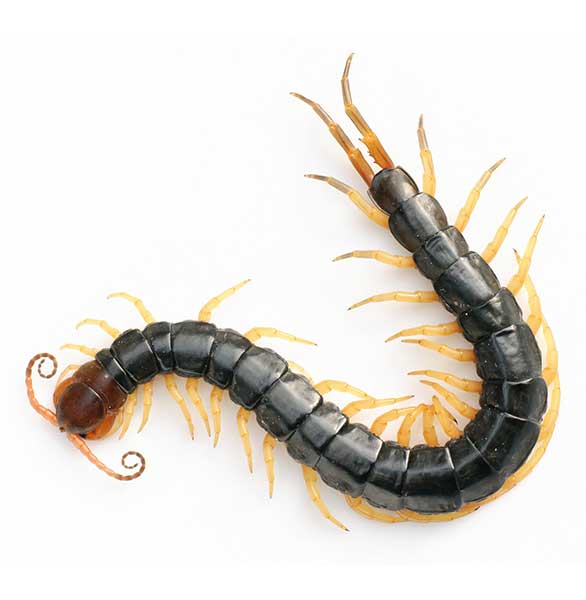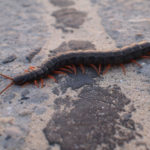Welcome To Our Centipede Learning Center
CentipedesCentipedes can be found all over the world, but it’s best when they are outdoors and not in your home. If you have an infestation then you likely have something that they want in your home. Centipedes are carnivores that eat other pests, such as spiders, cockroaches, crickets, moths, earthworms, silverfish, and bed bugs. If you are noticing centipedes in or around your home, it’s time to call Stride Pest Control right away.
(Scutigera coleoptrata)
Description
Centipedes are a type of arthropod belonging to the class Chilopoda. They are elongated, flattened creatures with numerous legs. Centipedes are elongated segmented creatures with one pair of legs per body segment. Despite the name, no centipede has exactly 100 pairs of legs. They can have anywhere from 30 to 382 legs. All centipedes are venomous and can inflict painful bites. While most species are not dangerous to humans, some larger species can deliver a painful bite that can cause swelling and other symptoms. Therefore, you should approach these pests with care.

Additional Information
Location
Centipedes are found all over the world, in a variety of environments including deserts, forests, and caves. They are versatile and can live in forests, savannahs, deserts, and prairies.
However, if you see them in your house in Texas, they are likely the giant red headed centipede. These centipedes live in cool, dark, and humid environments. They can be found in bathrooms, basements, and cellars. They tend to be wary of people and make sure they are not seen.
Habits and Behavior
Centipedes are primarily nocturnal, feeding on a variety of insects. During the day they seek shelter under objects on the ground, inside logs and stumps, or in animal burrows. During the hot, dry weather, they will usually bury themselves deep in the soil. When awake, they spend their time moving about the environment in search of food and mates. Humans are most likely to encounter centipedes in the spring as the weather gets warmer. They are also out in the autumn and fall, when the cooling weather forces them to find shelter in homes and other buildings.
Centipedes are not territorial but can attack and bite humans when provoked. Many larger animals prey upon centipedes, such as mongooses, mice, salamanders, birds, and snakes. Some centipedes are capable of secreting sticky, toxic secretions to defend themselves from these predators.
Lifecycle
Centipede reproduction does not involve copulation. Instead, males deposit a spermatophore, or capsule of sperm, for the female to take up. Females lay eggs in the spring and summer, typically in soil. The number of eggs ranges from 10 to 50, with hatch time varying from 1-3 months. The reproductive period for centipedes can also vary, ranging from 1-3 years.
Centipedes are relatively long-lived compared to insects. The average lifespan is 5-6 years, while some species can live 10 years or longer.
Centipede Control and Prevention
Nobody wants centipedes in their home, although the good news is that these pests do not cause damage. Still, here are some ways to keep them outside where they belong:
- Keep your yard free and clear of debris. Centipedes thrive in dark places, such as under rocks, in leaf piles, and in soil.
- Fix water leaks. Centipedes will seek shelter when it is too hot or dry outside. Minimize moisture inside and outside your home.
- Get rid of other pests. Centipedes are carnivorous, feeding on worms, spiders, and other insects. If you get rid of these pests, you get rid of the centipedes’ food source, therefore, making your home less appealing to them.
- Fix exterior crevices. Centipedes can enter through fairly small access points. Sealing up cracks and crevices in the foundation can help keep them out.
- Fix holes around doors and windows. Centipedes can also enter through holes and openings around doors and windows, so seal them up with caulk.
- Install door sweeps on exterior doors. Centipedes like to take the easy way in and enter through the door. You can prevent this from happening by installing door sweeps.
Contact Us Today for Centipede Control in Austin
 Seeing a centipede in your home can be cause for alarm, as they have a startling appearance. Let the friendly Austin centipede control team at Stride Pest Control help you get rid of these pests for good.
Seeing a centipede in your home can be cause for alarm, as they have a startling appearance. Let the friendly Austin centipede control team at Stride Pest Control help you get rid of these pests for good.
Schedule a free inspection today and we’ll do the rest. Fill out the online form or call (512) 515-3635 (Austin) or (210) 940-3902 (San Antonio) to get started.
Average lifespan of a House Centipede in years
3-7
Pairs of legs
when born
4
Average eggs a female will lay
63-150
Average number of legs a Centipede has
30-354
GET A FREE CONSULTATION TODAY!
Get a FREE Consultation

